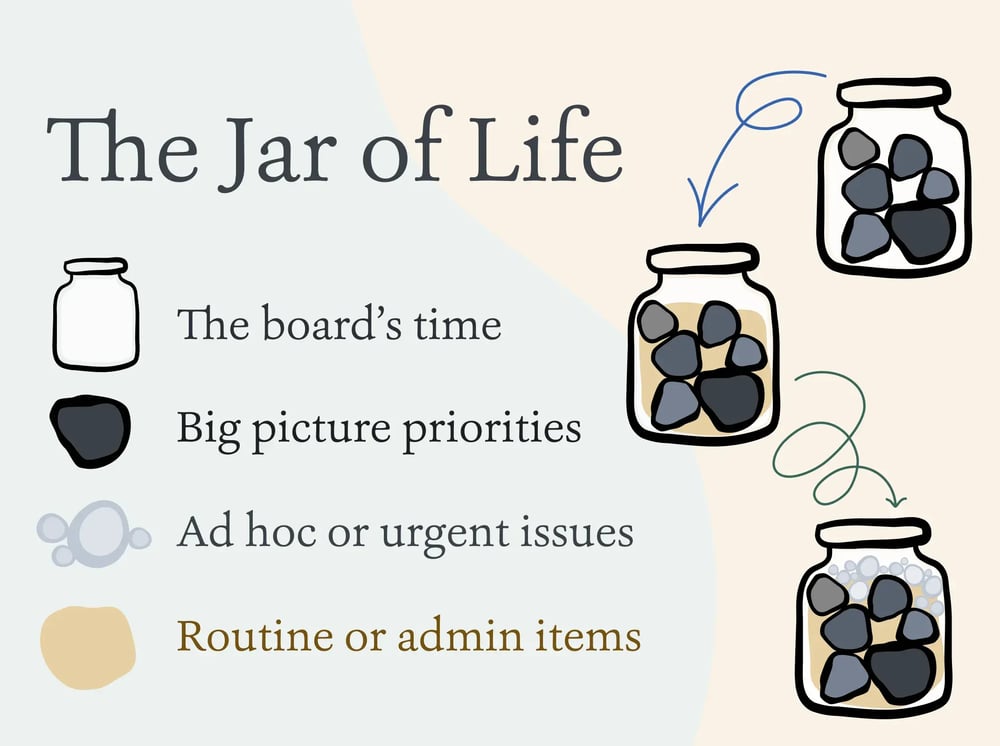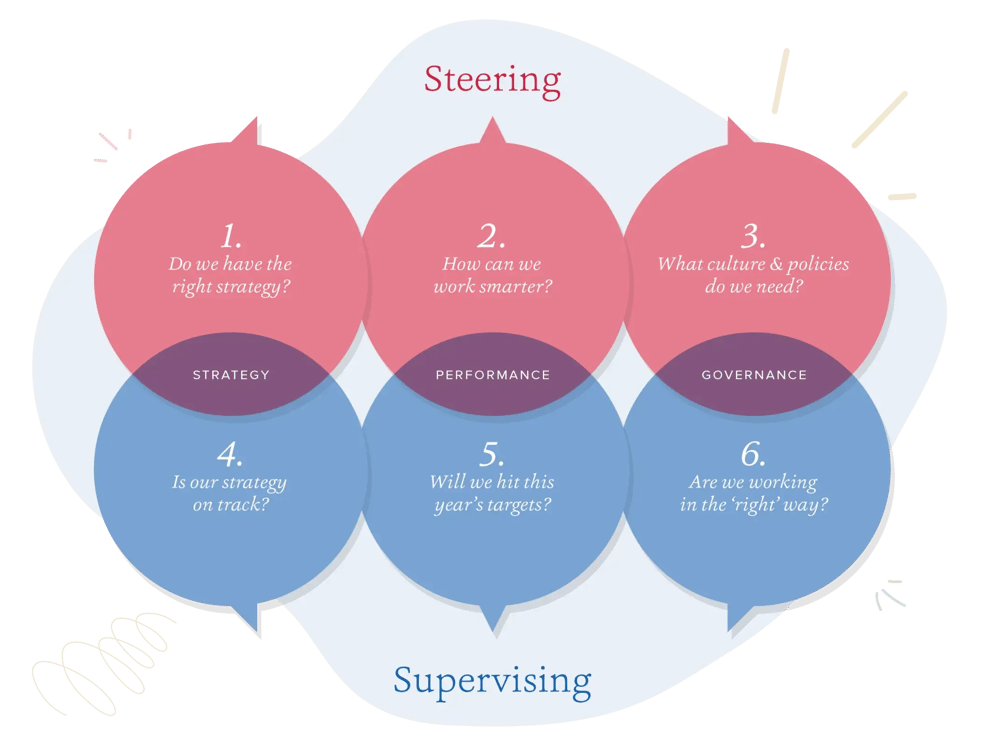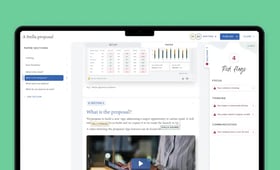“Meetings are where minutes are taken and hours are wasted.” This quote may often be attributed to a fictional character — spaceship commander Captain James T. Kirk — but it makes a point that’s painfully real: according to a 2022 University of North Carolina study, a third of meetings are completely unnecessary.
As well as being unnecessary, they’re also expensive, costing large companies over $100m a year. Which is why many organisations have taken a scythe to their calendars, scrapping recurring meetings with more than two or three people, introducing “no-meeting days”, and limiting meetings to 30–45 minutes to reduce the burden.
Unfortunately, none of these productivity hacks can be applied to our most expensive, and arguably most important, get-togethers: board meetings.
The board is not day-to-day, but from great material, 4–5 meetings per year, and various discussions they must mitigate, protect, and anticipate risk before it starts to affect the company.”
Chris Perry, President, Broadridge Financial Solutions
Our joint research with the Chartered Governance Institute UK & Ireland shows the average cost of board and committee meetings at large organisations hovering around £300,000 per year since 2020. And yet, few are confident that this investment delivers an appropriate return. In a recent Board Intelligence survey, 91% of business leaders said their board needed to spend less time in the weeds to focus more on the organisation’s big-picture vision and goals, suggesting boards find it hard to focus their limited time together on the things that matter most.
So, what can you do to make sure the board’s time is used wisely and that board meetings deliver the value we all expect?
How do you plan effective board meeting agendas?
Two simple tools can help governance teams, chairs, and CEOs to plan effective board meeting agendas and annual calendars.
The first, the “jar of life”, helps us to think in a more strategic and structured way about how we use directors’ time.
We start by thinking of the board’s time as an empty glass jar. It’s only so big, and there’s only so much you can fit in it — just like the board’s time, which is finite.
We can categorise the different types of conversation that directors typically have in their board meetings — all the things you need to cram into that jar — into three groups:
- First, are the big strategic discussions, significant decisions, and scheduled deep dives. Think of these as “rocks” — large, chunky, and inflexible.
- Then, there are the regular, routine, and administrative items like performance updates, compliance matters, and minutes. Think of these as grains of sand — they’re small but there are lots of them and they get everywhere.
- Finally, there are the ad hoc or urgent items that crop up and which are hard to plan for — a board member asks for a deep-dive on something or there’s a problem at the data centre that brings your tech stack down for a few hours, perhaps. Think of these as pebbles.
The traditional approach to agenda planning is to start with the sand (the routine items) and then add the pebbles (the urgent or ad hoc items which are front of mind). The problem with this approach, however, is that it doesn’t give you much room for rocks — making it more likely that routine or urgent topics will crowd out the chunky ones.

So, to make sure the board has time for the conversations that matter most — the strategic priorities that will move the organisation forward — you need to flip this approach around and start by putting the rocks in first.
Add the rocks to the agenda first and then add the sand, shaking the jar around a little to fill the gaps. And be ruthless: some sand can almost always be removed altogether by delegating it to a committee, discussing it less frequently, or taking the conversation “offline” and dealing with the matter asynchronously.
Once you’ve done this, there should be some headroom left for the pebbles — time you can freely allocate to the ad hoc items that crop up, knowing that you’ve made sufficient room for everything else.
Building your agenda this way means your board can spend more of its limited time on the topics that matter, with an agenda that’s led by the organisation’s priorities, rather than by an administrative “to do” list.
How do you work out what the board’s priority conversations are?
Following the right process is only part of the solution; you also need to know what those rocks, or priorities, are. And that’s easier said than done when boards are juggling a vast and expanding workload. One director once complained to us that his board needed a horizontal agenda to deal with its 20 “number one” priorities.
This is where the second tool, the “Six Conversations” model comes in. It helps boards to identify the mission-critical discussions that will help the organisation to deliver its big-picture vision and goals, so that meeting agendas and annual calendars can be built around the conversations that matter.

Using this model, the board’s vast remit can be organised into six categories, or conversations. These conversations cover strategy, performance, and governance – the main areas for reporting and discussion – and can be looked at in two different ways, reflecting the two roles that boards perform at any given time:
- Steering — the board’s role in shaping the organisation and helping it to achieve its long-term aims.
- Supervising — the board’s role in monitoring performance and seeking assurance.
Using this simple framework, boards can identify the question, or questions, that they need to grapple with in each of these categories over the coming year. These questions are the priorities, or “rocks”, that the board calendar needs to be built around.
Once these priorities have been identified, the board can work out what weighting to give each of them – to decide how frequently, and for how long, it needs to talk about them in any given meeting or across the year. The board can also step back and assess whether it has too many priorities, so that some can be delegated to management or committees, for example, to avoid overcrowding the agenda.
In addition to providing the foundation for the board’s annual calendar and meeting agendas, the model also gives governance teams a framework for assessing whether the board is fulfilling its duties and covering everything it needs to, in the right balance, across the year.
And that’s particularly important because so many boards don’t get that balance right; discussions are often biased towards supervisory discussions and performance questions like “Will we hit this year's targets?”, at the expense of strategy and steering discussions. No surprise then that Board Intelligence research found that only 16% of directors felt they spent too much time on performance, while 44% felt short-changed by the amount of time they spent on strategy.
Translating our priorities to agendas gives the board and me confidence we’ll use our time well.”
John Pettigrew, CEO, National Grid
How do you turn board agenda planning theory into practice?
The first step is to take a step back, assess where your board has been spending its time, and identify what needs to change. What is the right balance for your board, and how far are you from achieving it? What is your board not discussing?
The second step is a structured consultation process led by the chair and company secretary, and involving the executive team and the board, to define a clear mandate and set of priorities for the board. The Six Conversations Model is a useful framework for this process. You can also work with a team of experts to facilitate a board priorities and agenda planning exercise that results in a focused board calendar of robust, yet flexible, meeting agendas.
The final step, once the board has a clear set of priorities and a structured approach to agenda planning, is to translate this into an operational process. Most boards plan their agendas well in advance, but we all know that things change — and that keeping on top of all the moving parts in spreadsheets and other documents can keep governance professionals awake at night.
Board Intelligence’s Agenda Planner tool is designed to take the complexity out of setting forward agendas. From a single view, you can plan your forward calendar and manage last-minute changes with a simple “drag and drop” feature. You can also track where your board spends its time and proactively course-correct, so you can more easily evidence compliance (for example, with Section 172 in the UK) and ensure that it’s your board’s priorities, not convention, driving your organisation forward.

Transform your reporting with expert advisory services from Board Intelligence and deliver the insight your leaders need.
Find out more


